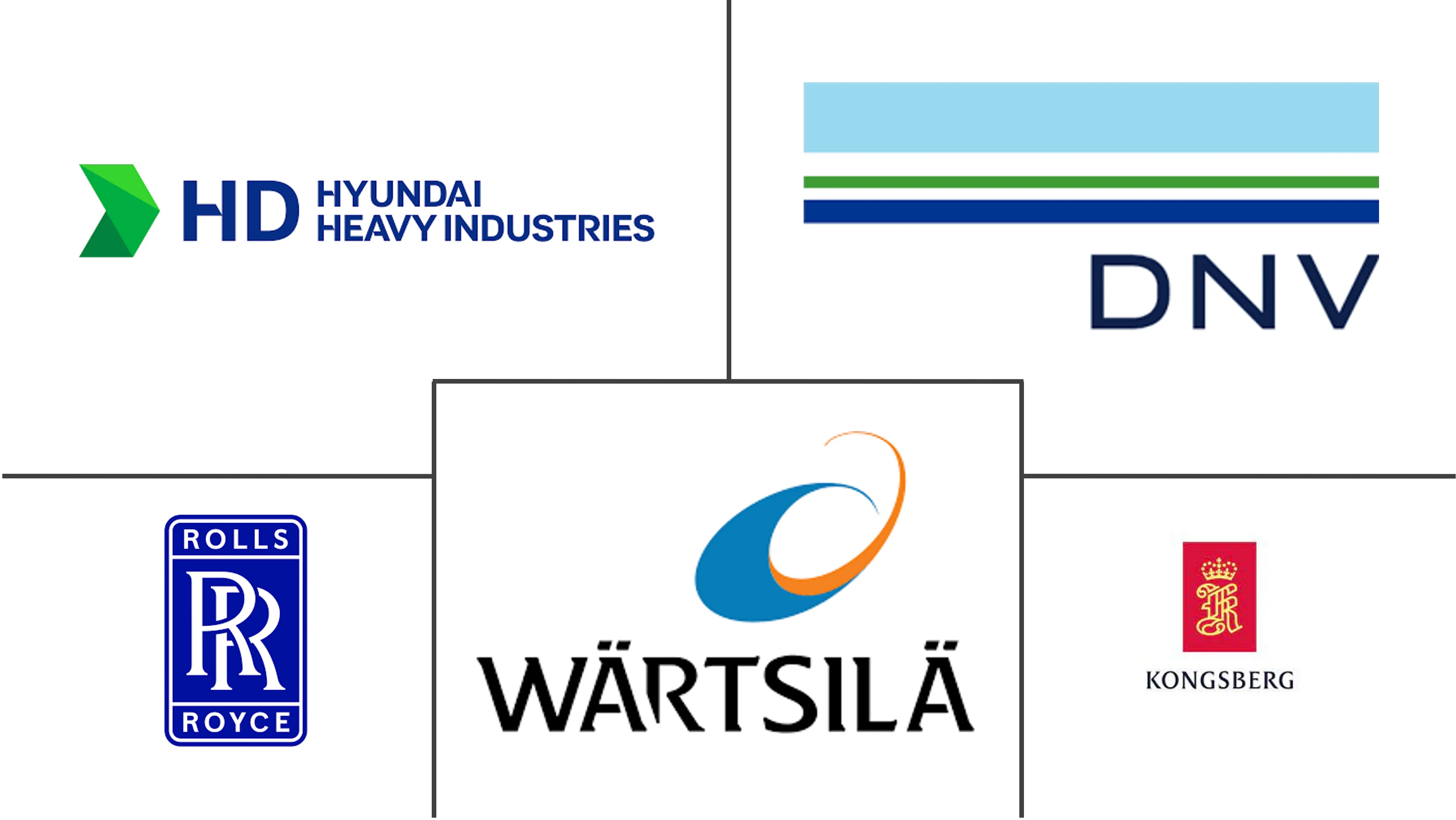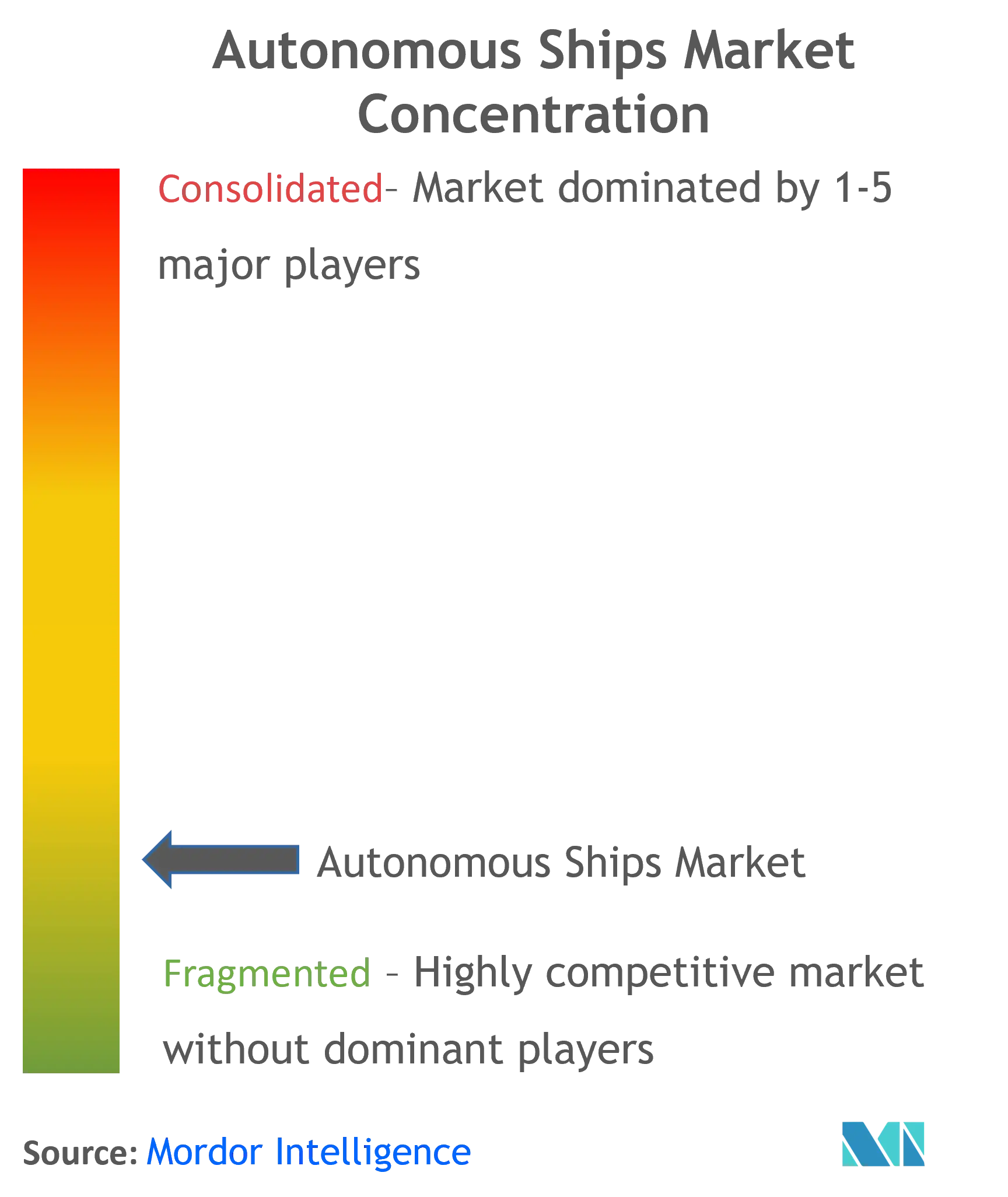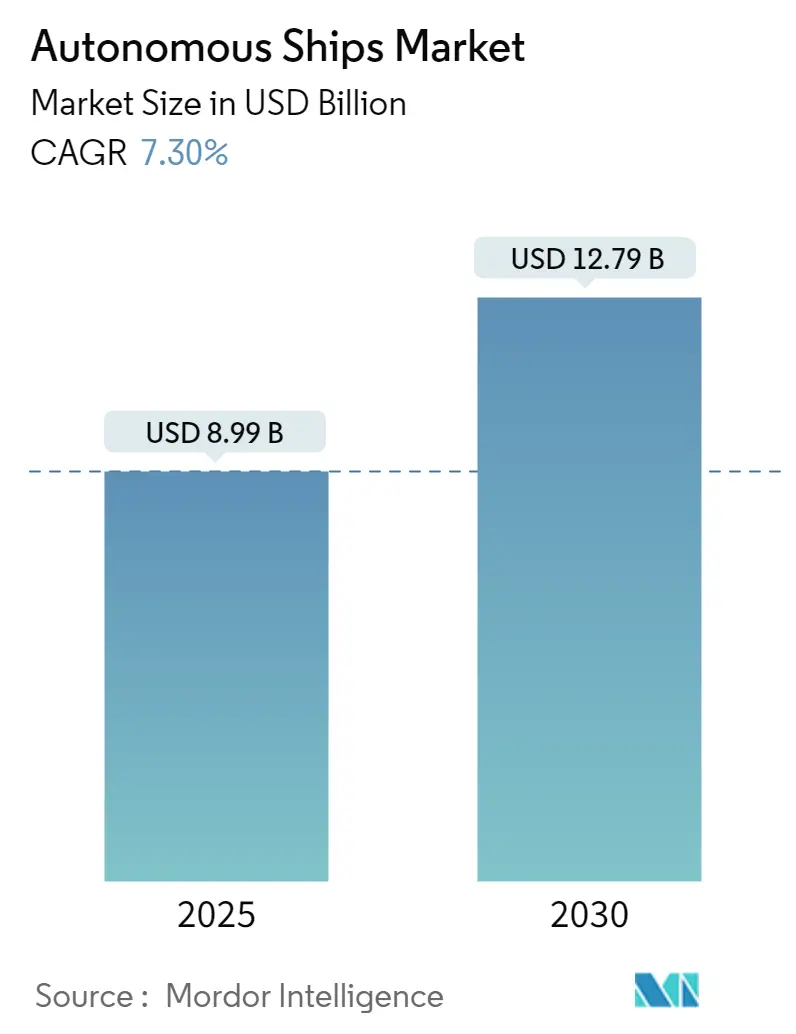
Autonomous Ships Market Analysis
The Autonomous Ships Market size is estimated at USD 8.99 billion in 2025, and is expected to reach USD 12.79 billion by 2030, at a CAGR of 7.3% during the forecast period (2025-2030).
The demand for autonomous and remotely controlled ships is growing at a rapid pace due to the developments in sensor technology, connectivity at sea, and analysis and decision support software and algorithms (artificial intelligence) for various onboard applications, like navigation and situational awareness. The autonomy of the shipping industry is expected to reduce maritime emissions, enable massive fuel savings, and save about 20% of the cost incurred for shipping operators. Additionally, according to the European Maritime Safety Agency (EMSA), 58% of accidental events and 70% of accidental events were attributed to human error in shipboard operations. This technology is anticipated to apprehend such accidents due to human error on the bridges of the vessel, thereby reducing the accidents onboard.
In several countries, like Finland, the UK, Norway, South Korea, China, and Japan, various companies (in different industries, like shipbuilding, engine manufacturers, big data, and other software providers) are collaborating and forming research alliances to increase the human-machine interface and incorporate autonomy into the naval architecture. Such collaborations are expected to propel the growth of the market during the forecast period. The cost for integration of autonomy into naval vessels, the threat of cybersecurity, and the reliability of software and machinery aboard the vessels are anticipated to act as barriers to the growth of the autonomous ships market during the forecast period.
Autonomous Ships Market Trends
The Commercial Segment of the Market is Anticipated to Register the Highest Growth During the Forecast Period
The development of new autonomous naval vessels with the advancement of technologies and the incorporation of sensor systems in commercial vessels, like cargo vehicles, passenger ferries, and other platforms, is anticipated to propel the growth of autonomy in the commercial segment. Integration of autonomy is a costly and slow process, especially in the maritime industry, as the adoption rate of new technologies is relatively slower compared to other transportation systems. Therefore, commercial operators are starting with remote-controlled vessels and making long-term plans to replace traditional ships with autonomous ships.
Some of the liner shipping companies, like Maersk, CMA CGM, and Hapag-Lloyd, and cruise operators established remote operating centers (ROCs) for their fleets for several years. These help in monitoring the data on the bridge and assist the crew on board in operating the vessel. Some of the companies are collaborating with technology providers and accelerating the development of new autonomous ships.
In September 2022, DNV (Norway) signed an MOU with Hyundai Heavy Industries Co., Ltd., Avikus, and Liberian International Ship & Corporate Registry (LISCR). It includes a joint study to deploy autonomous navigation systems on board ships to increase technology uptake by the industry and flag states. The Hyundai Intelligent Navigation Assistant System (HiNAS 2.0) is an AI-based navigation solution that covers all steps of a voyage, from detection to situation analysis, planning, and control. The system assists in safe navigation by displaying AR (augmented reality) images of detected ships and navigation information.
Similarly, in August 2023, DeepOcean (Norway) entered a long-term agreement for a new-built unmanned surface vessel (USV) for use in subsea inspection, maintenance, and repair (IMR) and survey support for offshore oil and gas and renewable energy. Despite being remotely controlled from shore, the USV will include various autonomous features to ensure the safety and integrity of the spread. It can also perform in severe weather conditions.
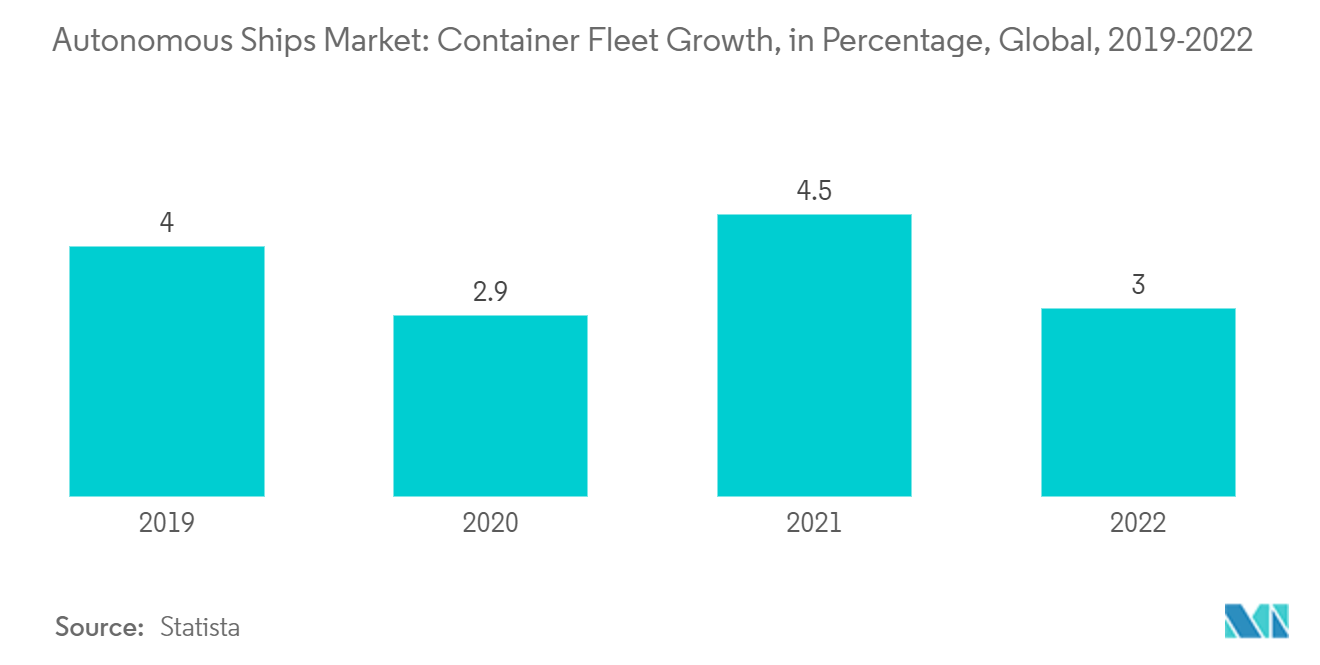
Europe is Expected to Generate the Highest Demand During the Forecast Period
The increasing investments and initiatives from the European governments and companies into autonomous ships are majorly driving the growth of the market. One Sea - Autonomous Maritime Ecosystem is the major European collaboration by ABB, Ericsson, Cargotec (MacGregor and Kalmar), Meyer Turku, Rolls-Royce plc, Tieto, and Wärtsilä Corporation. It began in 2016 to enable commercial autonomous maritime traffic by 2025. Similarly, Finnish-based companies are working on a research project called Ecosystem for Autonomous Ships. It is a collaborative platform that aims to introduce the world's first autonomous marine transport system by 2025.
In addition to this, the companies are supporting government initiatives to introduce autonomous capability into naval vessels. For instance, DNV GL, a Norway-based company, is involved in many projects on autonomous ships. One such project is the Norwegian Forum for Autonomous Ships (NFAS), which the Norwegian Government supports. Furthermore, the UK-Norwegian collaborative project called Safe Implementation of Autonomous and Remote Operation of Ships (SIMAROS) plans to develop a fully autonomous offshore vessel, Hrönn. Therefore, such plans to develop and induct autonomous ships may aid the rapid growth of the autonomous ships market in Europe during the forecast period.
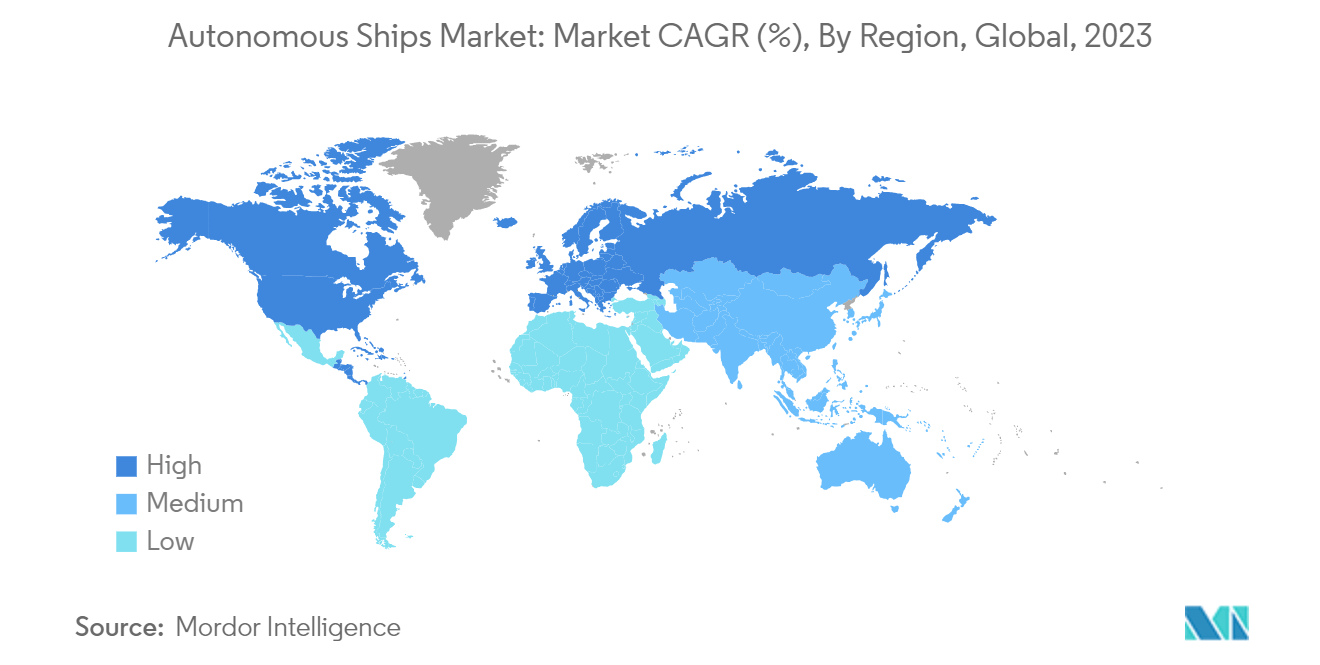
Autonomous Ships Industry Overview
The market for autonomous ships market is fragmented, with many regional players that their local governments fund to collaborate and develop autonomous ships. The prominent players in the autonomous ship market are DNV AS, Kongsberg Gruppen ASA, Rolls-Royce plc, Wärtsilä Corporation, and HD Hyundai Heavy Industries Co., Ltd.
DNV AS, Kongsberg Gruppen ASA, and Rolls-Royce plc are the manufacturers of the ships. In contrast, Wärtsilä Corporation, Praxis Automation Technology BV, and Valmet Corp are some of the prominent component providers that support shipbuilding companies with essential automation technologies.
To further integrate the developments in the sensors, Big Data, and artificial intelligence technologies, the shipbuilding companies are collaborating with the IT companies. For instance, in September 2021, the design and engineering consultancy BMT unveiled its 'Highly Autonomous Warship Technologies' project. It is designed to help bridge the gap between current vessels and future lean-crewed autonomous warships. The program aims to understand and enable philosophies behind the future lean crewed warships by autonomy. Such initiatives are anticipated to maximize the penetration of the market into the shipping industry, which, in turn, will help the companies to capitalize on profits.
Autonomous Ships Market Leaders
-
Kongsberg Gruppen ASA
-
Rolls-Royce plc
-
Wärtsilä Corporation
-
HD Hyundai Heavy Industries Co., Ltd.
-
DNV AS
- *Disclaimer: Major Players sorted in no particular order
Autonomous Ships Market News
- February 2023: Austal USA delivered the US Navy its autonomous capable EPF 13 ship. Austal integrated an automated maintenance, health monitoring, and mission readiness capability into EPF 13. It will enable the vessel to operate for up to 30 days without human intervention in combination with existing highly automated hull, mechanical & electrical systems installed on EPF class vessels.
- August 2022: Avikus, a subsidiary of HD Hyundai Heavy Industries, received an autonomous navigation solution order from SK Shipping and Sinokor Merchant Marine. Under the contract, the Avikus HiNAS 2.0 autonomous navigation solution would be installed on 23 vessels, including container ships and LNG carriers.
Autonomous Ships Industry Segmentation
The International Maritime Organization (IMO) defined maritime autonomous surface ships (MASS) as a ship that, to a varying degree, can operate independently of human interaction. It identified four degrees of autonomy in ships, which are defined as follows: Degree one: A ship that is operated by seafarers with some of the processes automated. Degree two: Remotely controlled ship, controlled and operated from a different location with seafarers on board. Degree three: Remotely controlled ship, controlled and operated from a different location without seafarers on board. Degree four: Fully autonomous ship with an operating system that will make decisions and determine actions by itself. The military segment of the market study includes autonomous ships and unmanned surface vehicles.
The autonomous ships market is segmented by type, application, and geography. By type, the market is segmented into partially autonomous, remotely controlled ships, and fully autonomous. By application, the market is segmented into commercial and military. The report also covers the market sizes and forecasts for the autonomous ships market in major countries across different regions. For each segment, the market size is provided in terms of value (USD).
| Type | Partially Autonomous | ||
| Remotely Controlled Ship | |||
| Fully Autonomous | |||
| Application | Commercial | ||
| Military | |||
| Geography | North America | United States | |
| Canada | |||
| Europe | United Kingdom | ||
| Germany | |||
| France | |||
| Italy | |||
| Russia | |||
| Rest of Europe | |||
| Asia-Pacific | China | ||
| India | |||
| Japan | |||
| South Korea | |||
| Australia | |||
| Rest of Asia Pacific | |||
| Latin America | Brazil | ||
| Rest of Latin America | |||
| Middle-East and Africa | Saudi Arabia | ||
| United Arab Emirates | |||
| Qatar | |||
| Egypt | |||
| South Africa | |||
| Rest of Middle-East and Africa | |||
Autonomous Ships Market Research FAQs
How big is the Autonomous Ships Market?
The Autonomous Ships Market size is expected to reach USD 8.99 billion in 2025 and grow at a CAGR of 7.30% to reach USD 12.79 billion by 2030.
What is the current Autonomous Ships Market size?
In 2025, the Autonomous Ships Market size is expected to reach USD 8.99 billion.
Who are the key players in Autonomous Ships Market?
Kongsberg Gruppen ASA, Rolls-Royce plc, Wärtsilä Corporation, HD Hyundai Heavy Industries Co., Ltd. and DNV AS are the major companies operating in the Autonomous Ships Market.
Which is the fastest growing region in Autonomous Ships Market?
Europe is estimated to grow at the highest CAGR over the forecast period (2025-2030).
Which region has the biggest share in Autonomous Ships Market?
In 2025, the Europe accounts for the largest market share in Autonomous Ships Market.
What years does this Autonomous Ships Market cover, and what was the market size in 2024?
In 2024, the Autonomous Ships Market size was estimated at USD 8.33 billion. The report covers the Autonomous Ships Market historical market size for years: 2019, 2020, 2021, 2022, 2023 and 2024. The report also forecasts the Autonomous Ships Market size for years: 2025, 2026, 2027, 2028, 2029 and 2030.
Our Best Selling Reports
Autonomous Ships Industry Report
The autonomous ships industry is experiencing remarkable growth, fueled by technological advancements and increased R&D investments. This market, analyzed in detail by Mordor Intelligence™ Industry Reports, spans commercial and military applications, with a notable demand in next-generation cargo ships for their efficiency and reduced operational costs. The military sector seeks to leverage these vessels for improved naval defense. Innovations in propulsion, including electric and hybrid models, are propelling the industry forward, particularly in the Asia-Pacific, Europe, and North America, due to their strong shipbuilding sectors and regulatory support. Despite facing cybersecurity and regulatory challenges, the autonomous ships market is on a trajectory of substantial growth, driven by strategic partnerships and ongoing innovations. For a comprehensive market forecast and historical overview, access a free report PDF download from Mordor Intelligence™.

